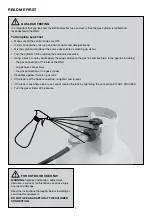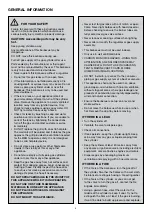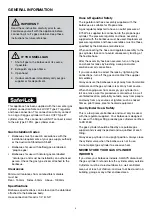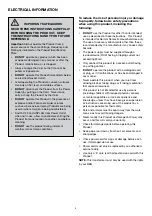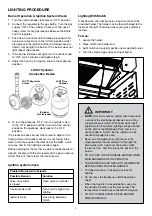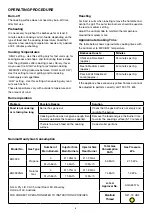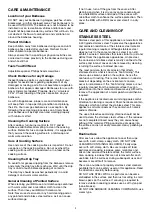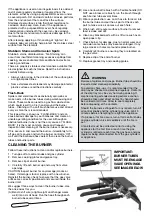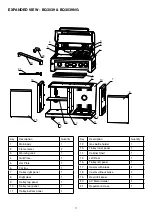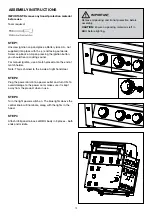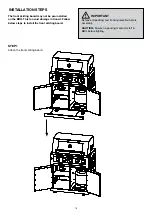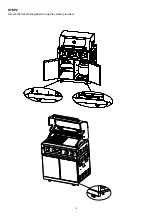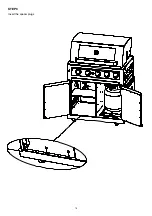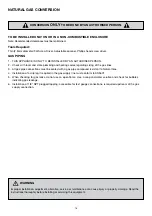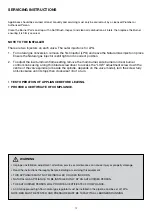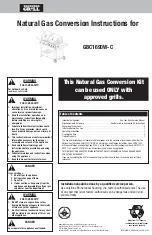
11
10
WARNING
Beware of spiders and wasps. Burner tube should be
inspected and cleaned periodically.
To avoid any flare-ups, it is recommended that the
drip tray be checked and emptied regularly. Contents
of the drip tray may be very hot during cooking. If
emptied during extended cooking extreme caution
should be taken and direct contact by hand should
be avoided at all times. Allow to cool completely
before disposing of the contents.
Should the burners extinguish for any reason, turn off
all control knobs and the cylinder gas valve. Wait 5
minutes before attempting to relight the appliance.
If a grease or fat fire occurs, turn off all control knobs
and gas cylinder valve immediately until the fire is
out.
A leak test must be carried out prior to using the
appliance for the first time or each time the gas
cylinder is refilled or each time the gas hose and gas
regulator being disconnected from the gas cylinders
or appliance.
If the appliance is used on an irregular basis it is advised
to still clean regularly and keep it covered from the
elements, either by using a purpose BBQ cover or under
a covered porch. Dirt and dust contain corrosive particles
from the environment that can attack the surface.
Stainless steel surfaces retain their best resistance to
corrosion when keep clean. Even if the appliance is
protected with a purpose BBQ cover check regularly,
condensation underneath the cover may be corrosive
due to the local environment and cause damage to the
metal surface.
After cleaning applying a thin coating of ‘light oil’, for
example baby oil, will also help protect the stainless steel
surface from the elements.
Stubborn Stains and Corrosion Spots
Stubborn stains, discolouration, ‘Tea Staining’ can
occur from insufficient cleaning, excessive spillage from
cooking, severe environmental conditions and extreme
cooking conditions.
There are propriety stainless steel cleaners available that
are designed for such instances. Read the instructions
carefully before using.
• Always rub or wipe in the direction of the surface grain
or original polish lines.
• Some stainless steel cleaners may damage painted or
plastic surfaces, read the directions carefully.
Flash-Back
Spiders and small insects occasionally spin webs or
make nests in the burner tubes during warehousing and
transit. These webs can lead to a gas flow obstruction
which could result in a fire in and around the burner
tubes. Cleaning with a soft brush before use and at least
every six months is recommended.
This type of fire is known as ‘FLASH-BACK’ and can
cause serious damage to your barbecue and create an
unsafe operating condition for the user. Although an
obstructed burner tube is not the only cause of ‘FLASH-
BACK’ it is the most common cause and frequent
inspection and cleaning of the burner tubes is necessary.
If fire occurs in and around the burner, immediately turn
off gas at its source and turn the burner control to ‘OFF’,
wait until the barbecue has cooled, then clean the burner
tubes and burner ports.
CLEANING THE BURNER
Follow these instructions to clean and/or replace burners.
1. Turn gas off at control knobs and gas cylinder.
2. Remove cooking grates and grease tray.
3. Remove clip at end of burner.
4. Carefully lift each burner up and away from valve
openings.
CAUTION: Inspect burner for any damage (cracks or
holes). If damage is found, replace with a new burner.
Reinstall the burner, check to ensure that the gas valve
orifices are correctly positioned and secured inside the
burner inlet.
We suggest three ways to clean the burner tubes. Use
the one easiest for you.
(A) Bend a stiff wire (a light weight coat hanger works
well) into a small hook. Run the hook through each
burner tube several times.
IMPORTANT:
BURNER TUBES
MUST RE-ENGAGE
VALVE OPENINGS.
SEE IMAGE BELOW
(B) Use a narrow bottle brush with a flexible handle (DO
NOT use a brass wire brush), run the brush through
each burner tube several times.
(C) Wear eye protection: use an air hose to force air into
the burner tube and out the air ports. Check each
port to make sure air comes out each hole.
5. Wire brush entire outer surface of burner to remove
food residue and dirt.
6. Clean any blocked ports with a stiff wire such as an
open paper clip.
7. Check burner for damage, due to normal wear and
corrosion some holes may become enlarged. If any
large cracks or holes are found replace burner.
8. Carefully refit burners, ensuring they are located on
the gas valve.
9. Replace clip at the end of burner.
10. Replace grease tray and cooking grates.


